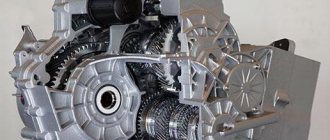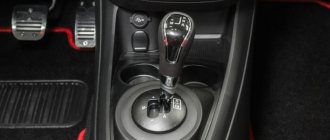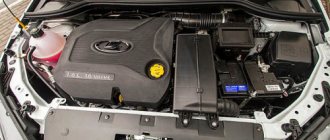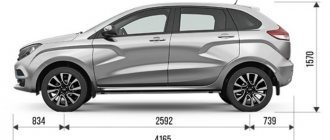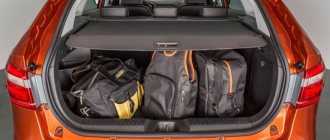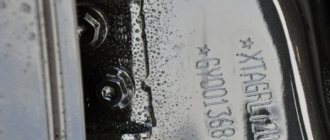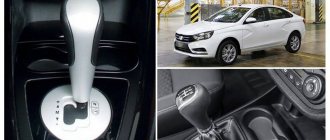The robotic gearbox is a joint development of AvtoVAZ together with the German company zf.
How does a “robot” work?
The robot is still the same 2180 gearbox with a cable drive with redesigned mounts, but in addition with an installed automatic shift mechanism, which was developed by the German company ZF. The automatic “actuator” mechanism depresses the clutch for you, puts the gear in gear, and releases the clutch.
The robot selector has the following positions:
N – neutral
R – reverse gear
M – manual switching mode
Vesta robot control diagram
In fact about the robot: Is it worth buying a car with a Robot?
If you are interested in the question of whether it is worth buying a robot, we will tell you: sign up for a TEST DRIVE, because it is free. Only by experiencing the robot’s operation yourself will you be able to understand whether it is suitable for you or not. If it doesn’t fit, then a manual transmission package is waiting for you.
AvtoVAZ says that the gearbox is suitable for everyone; AMT has 20 different switching algorithms. But this is not entirely true.
A little from myself: If you have a harsh character and you need appropriate behavior from a car, a robot is not for you. The robot is designed for calm, leisurely driving at medium speeds with smooth shifts and saving fuel and the clutch disc. And the question immediately arises of how this transmission will perform on Vesta Sport: how much the settings will be changed, whether sportiness will appear, etc.
Service life of AMT according to instructions and actual
The AvtoVAZ manufacturer indicates a warranty life of an automatic transmission of 75,000 km or 5 years.
In general, AMT takes care of the designated resource, but already in the first ten it is necessary to carry out small works:
- replacing the clutch disc;
- flashing of the electronic control unit;
- tightening the pressure bearing;
- replacing the sealing gland on the AMT.
Conclusion
The presence of a robotic version of the gearbox on the Lada Vesta was greeted positively by many car enthusiasts. Although breakdowns do occur, they are not critical; in some cases they can be prevented by careful driving and timely maintenance. The final decision rests with the owner of the technical device.
Problems with the Robot
The AMT (robot) mechanism itself is quite reliable: The box is painfully familiar to all of us, and the actuator inspires confidence. The actuator has a service life of 10 years, officially it is not repairable, but now they do everything, and repairing such an actuator is not a problem, the main thing is to lubricate it well. But there are the following “jambs” with the robot, but mainly related to the first, early models:
Long switching . As mentioned above, this is not a problem, it is a feature. Use manual mode.
Valeo clutch . As it turned out, Valeo does not match the Vesta in terms of vehicle weight, which is why current models receive a Sax clutch. Valeo quickly wore out, there was a difficult start, slippage and clutch smell were felt. The first Vesta models received the Valeo clutch.
Advantages of the robot (AMT)
So, manufacturers have already announced positive qualities - this is, as mentioned above, low load and, accordingly, an increase in the service life of the box, as well as a reduction in production costs compared to foreign analogues. Positive reviews from car enthusiasts can already highlight the strengths of the Lada Vesta with robotic AMT: - fuel consumption is lower than when using an automatic transmission, - lubricants do not require replacement, and the clutch disc is designed for the entire service life of the box, - the robotic 5-speed gearbox is equipped with protection from chaotic switching of modes, preventing its breakdown, allows you to move in both automatic and manual modes - AMT understands commands well, with careful and measured work with the gas pedal, it moves smoothly from one gear to another, the existing delays when changing gears are small ( no more than 120 ms), - when a loaded car starts downhill, the “robot” adapts and begins to work more harshly, at the same time the hard start algorithm and the slope start assistant are triggered. — the absence of a “creeping mode” ensures reliability; to start, you need to put the lever in position “A” (auto mode) and lightly press the accelerator, the start occurs faster, without jerks and vibrations.
Advantages of "Robot"
The advantage of a robot over mechanics: convenience, because Only one leg is occupied, both hands are on the steering wheel.
The advantage of a robot over an automatic: it is more economical (What is the fuel consumption?) than a conventional automatic, you can tow a car, slipping is allowed on the roads, the dynamics of the “mechanics” are preserved.
It is also worth noting that the robot has protection against “crooked hands”. In other words, randomly switching the robot selector while driving will not cause any damage. In addition, Priora, like Vesta on a robot, can be started from a pusher, you can drag a trailer, tow a car - you just need to switch to mechanical mode.
The first robots were installed on the Lada Priora with a 1.6 liter engine producing 98 hp. But the robot has already been reprogrammed for the new 127 engine, paired with which Vesta will be produced.
Pros and cons of AMT compared to mechanics
| Advantages | Flaws |
| Gear activation clarity | Cost of major repairs after the end of the warranty period |
| Resetting several gears at the same time by sharply pressing the accelerator pedal | The price of a car on the secondary market is 30 - 40 thousand lower compared to a manual one |
| Fuel economy with moderate driving style | Delays when upshifting |
| No need to warm up for a long time at subzero temperatures | |
| It is allowed to start the car from a pusher at a speed of no lower than 7 km/h and no more than 24 km/h | |
| Unpretentious, does not require frequent maintenance |
Related link:
Map updates in the CityGuide navigator on a Lada Vesta car
Advantages and disadvantages
Naturally, like all things fundamentally different from their competitors, AMT has its own certain pros and cons compared to automatic transmission and manual transmission. As one would expect, there are slightly more advantages than disadvantages - and the latter are not so critical that they could scare an experienced driver.
- The combination of manual transmission and automatic transmission capabilities in one unit is the main and undoubted advantage of AMT. This unit not only gives the driver the opportunity to choose the use of driving technology, but also allows the car owner to quickly adapt to the conditions of using an unusual method of gear shifting.
- The unit operates without any problems during the entire warranty period (this information can be obtained by watching a video with a detailed description of its properties). Naturally, this requires high-quality care and respect for the car. It is advisable to change the oil in the robotic gearbox somewhat more often than shown in the technical data sheet of the unit.
- A CVT costs much less than a 100% automatic, which reduces the final price of the purchased car.
- Another advantage is that the robotic gearbox of the Lada Vesta has the ability to be additionally configured. Naturally, it must be done by real professionals so that changing the configuration does not cause it to fail.
The disadvantages include a slightly lower gear shift speed than on a standard automatic - however, this problem is solved by manually controlling the shift. However, the robotic gearbox of the Lada Vesta allows buyers of cars in the “Lux” configuration to enjoy maximum driving comfort, quite comparable to the level available until recently to much more expensive and pretentious foreign cars.
More details about Lada “Vesta” cars
Reviews Lada Vesta SV Cross AMT
There are a large number of reviews of the AMT Lada Vesta SV Cross on the Internet. All reviews are different, but for the most part the robot on Vesta is a problem-free unit. Although there are also people who are less fortunate. Basically, they spread the main negativity on the Internet. I chose the first 3 reviews I came across about the Lada Vesta robot:
1. Alexander, Orsk
So, the robot is on the Lada Vesta Cross. I quite liked it. Anything is better than a stick. The most unusual thing for me was that you need to control the gear shift with the gas pedal. If you press the gas pedal harder, the speed switches to lower. For example, you are driving 40 km/h in 3rd gear and want to overtake someone, then you press the gas harder and the gear changes to second.
Switching to the next speed occurs by slightly releasing the gas pedal. For example, you press the pedal to the floor, the car takes off, the revolutions increase, for example, to 3.5 thousand, then you release the gas and the gear switches to second. Something like this. In general, this robot is quite a suitable topic. But you have to get used to switching so as not to get stuck on the road. In terms of reliability, I can’t say anything yet, since I’ve been driving the car for two months. During this time nothing broke.
2. Oleg, Petropavlovsk-Kamchatsky.
Last year I bought a Vesta station wagon in Blues color. The AMT on Vesta Cross is definitely not the automatic that I owned before. Shifts aren't the smoothest. It switches jerkily, there is no talk of any smoothness. If you once drove a CVT and are thinking of switching to a robotic gearbox, then leave this idea. And if you have already bought it, then accept it. If the previous car had something mechanical, then you should like the robot. But it’s definitely not for traffic jams. You can drive on the highway, in the city without traffic jams - it’s easy. In terms of repairs and breakdowns, everything seems to be reliable. A friend of Priora has a robot. I've already skated 90 thousand on it - there are no breakdowns. Basically, the release bearing breaks, which seems to be no problem to change at any service center. The switching mechanism is German, made with high quality. Lasts a long time.
3. Alexander, Balakovo
The first impression of the robot on Vesta was incomprehensible. I had never driven an AMT before, only an automatic or a CVT. After the purchase, I got into the car, turned on the automatic transmission mode, released the brake, and the car stood still. I pressed the gas a little and it started moving. I drove around the city in automatic mode. At first, the box took 10-20 minutes to adjust to my driving style. I understand that it is adaptive. On the weekend I went to a dacha outside the city. When I got out on the track, I had to switch to manual mode, since the robot constantly turned on speed 5 already at 80 km/h. The auto shift mode is very smooth. Shifts are almost imperceptible. And the fuel consumption of the Lada Vesta Cross on a robot is slightly lower than on a manual one. In short, I am very pleased with the box and the car as a whole.
As you can see, I didn’t find any bad reviews about the AMT Lada Vesta Cross. Yes, of course, it is too early to talk about reliability. But AMT has already been tested by its predecessors - Priora, Granta and Kalina. There were no major damage to the box. Basically, AMT got all the sores and mechanical problems. And you can spit on the smoothness of switching, or you can forgive it. Just ask yourself the question: “Which foreign car has a robot that shifts gears smoothly?”
We also found an excellent video review of the Lada Vesta SV Cross AMT. We recommend watching it:
Gear ratio AMT Lada Vesta SV Cross
Everyone believes that the AMT on Vesta is similar to Grant, Kalina or Priora. This is not entirely true. We worked a little on the settings in the West robot. Yes, globally these boxes do not differ from each other, the only difference is in the gear ratio. For Vesta it is 3.9, and for the first trinity it is 3.7.
During the measurements, it was revealed that at a speed of 120 km/h the Vesta’s tachometer showed 3200 rpm, while the Granta, Kalina and Priora showed 3000 rpm.
Disadvantages of the robot on the Lada Vesta
The disadvantages of the robot are, in principle, standard, the main ones are: - first of all, gear shifting with a slight loss of traction torque, unlike an automatic transmission; and a long second gear with an inevitable whine and drop in acceleration when shifting.
A measured ride in a Lada Vesta with robotic AMT is surprisingly comfortable, but in any case, the car enthusiast will put the last point in the dispute.
Reason for the squeak
The lubricant that is in the clutch actuator dries out, clumps, and no longer performs the function for which it is intended. Therefore, after 2 years, depending on the mileage and driving style, a squeak appears. Some owners do not pay attention to it - you can drive up to 60 thousand km without lubrication.
If you add new lubricant, then the Lada Vesta with the robot will work up to 120 thousand km. Then the parts wear out, especially the plastic ones, and the actuator must be replaced with a new one.
Lada Vesta SV Cross AMT - how did it appear?
The AMT on the Lada Vesta SV is a unit already familiar to us, which has already appeared on other domestic models - Lada Priora, Granta, Kalina, X-ray. At first there were rumors that this same robot was developed by engineers from Renault-Nissan, but later these rumors were refuted. The AMT Lada Vesta SV Cross itself is AvtoVAZ’s own development.
In recent 2015, under the leadership of Vladimir Petunin, the first serial robot was developed. The basis was the usual 5-speed VAZ manual transmission 2180, which is already familiar to everyone. ZF electric actuators of German origin were used as the actuator. They are responsible for pressing the clutch and selecting gear for the driver. A shaft speed sensor also appeared at the gearbox. All together gave a robotic gearbox with the VAZ-2182 index:
Gear shift actuator for Lada Vesta SV Cross AMT
The actuator mechanism for selecting and switching speeds on the AMT Lada Vesta SV Cross looks like this:
1 — Gear selection drive 2 — Electric motor 3 — Gear selection drive 4 — Electric motor 5 — Gear selection rod
Actuators (electric motors) are used from German ZF.
